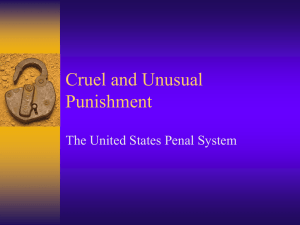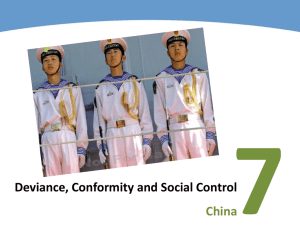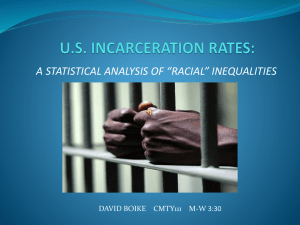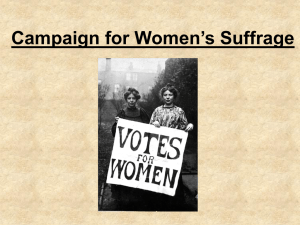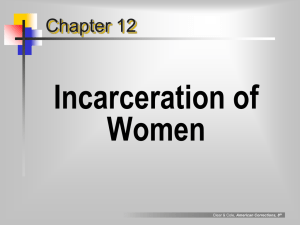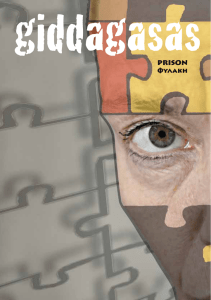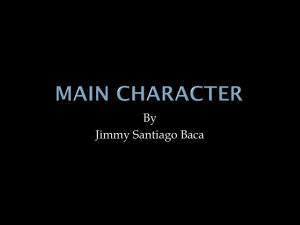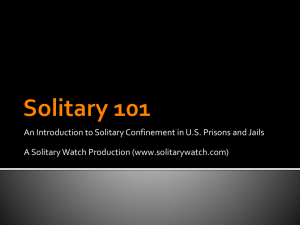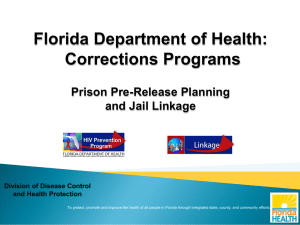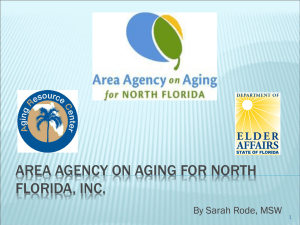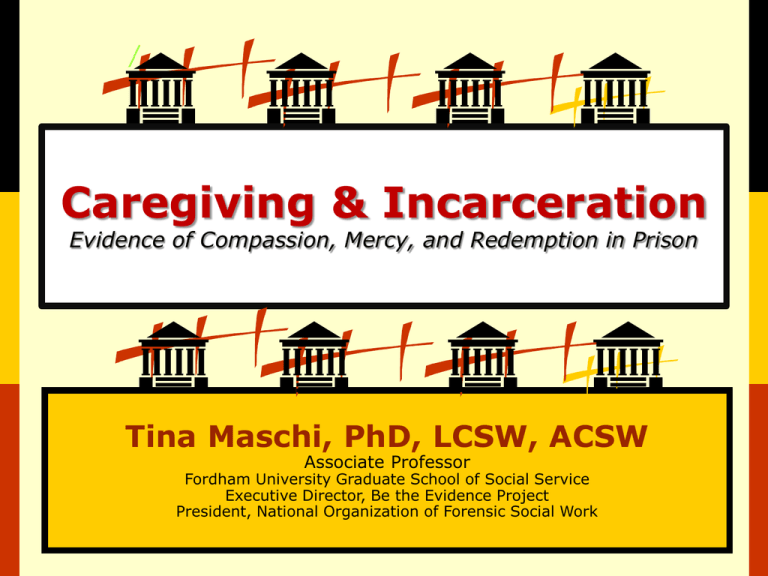
Caregiving & Incarceration
Evidence of Compassion, Mercy, and Redemption in Prison
Tina Maschi, PhD, LCSW, ACSW
Associate Professor
Fordham University Graduate School of Social Service
Executive Director, Be the Evidence Project
President, National Organization of Forensic Social Work
Overview
Human Rights
The State of Death, Dying, and
Prison Treatment as Usual
Peer Support, Compassion, Service,
among the Incarcerated
Peer Support Program Exemplars
Human Rights as a Framework for Care Giving and Receiving
The Whole Person in the Social Environment
Human Rights
Values
Dignity, Respect,
Intrinsic Value
Duty to Others
Human Rights
•
•
•
•
•
Political
Civil
Economic
Social
Cultural
Health &
Well-Being
Individual
Family
Community
• Root (basic needs)
• Physical
• Cognitive
• Emotional
• Social /Cultural
• Spiritual
• Participatory
(Maschi, 2011)
The Critical Omega Point:
How Did You Think We Got Here?
U.S-Global Mass Incarcerator (2.3 million in prison, 16%
aged 50 and older)
Accelerated aging (i.e., biological vs. chronological age,
e.g., early cognitive and physical decline, dementia,
early mortality) in prison populations
Record numbers die a year in prison of many causes
(e.g., U.S. in 2012; N = 5,000)
Lack of adequate specialized long term and hospice care
or use of compassionate release laws
Undignified Practices: Incarcerated person died in
shackles chained to his bed in New Orleans hospital
(1984)
(BJS, 2012; Finlay, 1998; Marushak,2008 WHO, 2010)
Understanding the Problem From A Heightened
Global Historic Consciousness Perspective
Common Cumulative Individual, Social
and Structural Determinants: for
Health, Well-being, and CJ Involvement
• Race
• Gender
• Age
•
•
•
•
•
•
•
•
•
•
•
•
•
•
•
•
•
Physical & Mental Disabilities
Empathy and Moral Development
Decision-Making and Problem
Solving Skills
Health Histories
Substance Use
Offense History
Trauma/Stress/Victimization
Poverty/Income
Education/Employment
Homelessness
Offense History
Oppression, Stigma,
Discrimination
Policies (Therapeutic Jurisprudence)
Social Support
• Family, Peers, Community
Access to Services or Legal
Assistance
Prior Service Use
Environment (Prison, Violence,
Inadequate Healthcare)
Trajectory of Care Giving Systems That
Influence Aging, Longevity, and Justice
The Pathway to the Black Box of
Prison for Older and Social
Disadvantaged Populations
Why the Rise of the Seriously Ill and
Dying in Prison?
General growth in global aging population
Ebb and flow of stricter punitive approaches
vs. compassionate/restorative approaches
1980s U.S. stricter sentencing policies (e.g., violent
crimes), disproportionate and unjust sentences and and
then adopted worldwide
Created rapidly growing international human made
disaster of the mass incarceration of elderly and other
socially disadvantaged groups
Additional Lack of Prison Restorative Justice Practice and
Fair Parole and Compassionate Release Laws and Practices
(ACLU, 2012; Aday, 2003; HRW, 2012; Maschi et al., 2011; in press; UNDOC, 2009; Wahidin, 2004; WHO, 2011; Williams et al., 2011, 2012)
Problem: Multisystemic Barriers
Corrections is ill-prepared to address the problem alone:
Providing holistic long-term health and social care; or
Addressing the cumulative determinants of disadvantage
(‘social determinants of health’)
Multi-system service and large scale policy reform that infuses
compassion and restoration
Training interdisciplinary professionals
Empowering individuals, families, and communities adversely
affected
Effectively addressing negative public attitudes towards
stigmatized groups and sensitive topics
attitudes towards aging, death and dying, crime and victimization, public safety counter arguments
(ACLU, 2012; Aday, 2003; HRW, 2012; Maschi et al., 2011; in press; UNDOC, 2009; WHO, 2011; Williams et al., 2011, 2012)
Heterogeneity of Aging in Place: The Intersection
of Sentence Length & Comorbid Special Needs
Prison Sentence Length
Possible Special
Needs Comorbidities
Life Course Older Adults in
Prison (Long-termer
Incarcerated early in life)serving long sentences
(20+ years) often for
violent offenses
Older Prisoners
Prisoners with Mental Health
Care Needs
Acute and Chronic Older
Person with Recidivism
History-cycle in and out of
prison
Prisoners with Disabilities
Foreign National Persons
Women
Late Onset Older Adult in
Prison-incarcerated later in
life and serving various
sentence lengths
Ethnic and Racial Minorities
and Indigenous Peoples
Lesbian, Gay, Bisexual, and
Transgender (LGBT) Persons
Persons Under Sentence of
Death
(may have one or more special needsimplications for access to justice)
(e.g.,Goetting, 1983; HRW, 2012; Maschi et al., 2012; Williams et al. 2012)
Age and Sentence Length-US State
Prisons
Sentence in Months
Age
≤20 years
21 – 30 years
31 – 40 years
41 – 50 years
51 – 60 years
61 – 70 years
71 – 80 years
≤ 120
Total
More than
Life without
240
parole
25,890
1,882
786
88.8%
6.5%
2.7%
0.3%
196,965
27,815
12,711
1,825
79.4%
11.2%
5.1%
0.7%
141,270
33,491
25,299
3,237
63.7%
15.1%
11.4%
1.5%
103,552
27,478
29,189
2,562
56.5%
15.0%
15.9%
1.4%
36,646
11,556
15,618
1,511
46.5%
14.7%
19.8%
1.9%
6,656
2,890
3,721
35.8%
15.6%
20.0%
1,047
32.7%
> 80 years
121-240
108
539
16.8%
57
83
18.1%
years
8
0.0%
0.0%
0.2%
0.4%
0.7%
2.3%
54
16.0%
15.1%
2.5%
512,134
105,708
87,959
9,778
65.4%
13.5%
11.2%
1.2%
19,119
12,618
16.0%
201
4,517
1.1%
24.3%
28
0.9%
9
30.2%
17,438
10.4%
580
75
8,490
7.9%
695
1.1%
Total
-
0.0%
0.1%
248,048
100%
471
0.2%
221,640
100%
520
0.3%
183,115
100%
307
0.4%
78,836
100%
113
0.6%
18,574
100%
9
0.3%
124
29,178
100%
153
924
28.8%
4
Death
529
3.4%
434
2.6%
Life
1.8%
89
476
581
Life plus
additional
3,203
100%
1
357
34.7%
0.3%
100%
2,039
63,759
1,574
782,951
0.3%
8.1%
0.2%
100%
(HRW, 2012, p. 26; National Corrections Reporting Program Note: Based on 24 states reporting year-end prison population data for 2009.
U.S. State Prisoners Statistics on Cause of
Deaths by Demographics (BJS, 2010)
TABLE 21
Number of state prisoner deaths,by cause of death and selected characteristics,2001-2010
Characteristic
Total
Sex
Male
Female
Race/Hispanic origin•
White
Black/African American
Hispanic/Latino
Otherb
Illness
liver
Respiratory
disease diseases
Heart
disease
Cancer
AIDS
All other
illnesses
8,415
7,833
2,442
2,025
1,540
6,086
1,994
398
290
515
8,234
181
7,500
333
2,318
124
1 ,921
104
1,460
80
5,739
347
1 ,893
100
384
14
278
12
511
4
4,428
3,194
685
101
4,195
2,827
661
129
1,299
607
473
60
1 ,101
711
189
21
318
1,040
169
12
2,800
2,384
792
97
1 ,158
419
330
80
231
72
79
16
157
89
35
8
234
176
88
15
80
408
1,296
2,366
4,262
0
43
200
882
2,498
4,206
8
54
381
1,226
772
45
139
276
484
1,078
0
16
204
661
512
147
2
93
368
1 ,070
2,088
2,460
9
288
656
571
341
129
0
24
111
146
88
29
22
64
74
72
57
64
144
149
106
51
Suicide
Drug/alcohol
intoxication
Accident
Homicide
Age
1 7 or younger
18-24
25-34
35-44
45-54
55 or older
Note: Data may have been revised from previously published statistics to reflect updated information.Detail may not sum to total due to missing data.
' Excludes persons ofHispanic/Latino origin unless specified.
blncludes American Indian or Alaska Native,Asian or Pacific Islanders,and persons identifying two or more races.
Source: Bureau of Justice Statistics,Deaths in Custody Reporting Program, 2001-2010.
Crime Type and Age-US State Prisons
(2009)
Offense Types Age < 55 Age ≥ 55
Violent
Sexual crimes
Total
436,509 44,924
89,193 16,892
481,433
106,085
173,685 8,425
165,594 8,225
95,722 6,678
Other/unspecified 8,245
512
Total
879,755 68,764
182,110
173,819
102,400
8,757
948,519
among violent
Property
Drugs
Public offense
Percent
≥ 55 in
offense
group
9.3%
15.9%
4.6%
4.7%
6.5%
5.8%
7.2%
Percent with Percent with
offense in ≥
55
offense in < 55
65.3%
24.6%
49.6%
10.1%
12.3%
12.0%
9.7%
0.7%
100%
19.7%
18.8%
10.9%
0.9%
100%
(HRW, 20120, p. 27; National Corrections Reporting Program Note: Based on 24 states reporting year-end prison population data for 2009.
Methods
Funder: John A. Hartford Foundation and Gerontological
Society of America-Geriatric Social Work Faculty Scholars
Award
Principal Investigator: Tina Maschi, PhD, LCSW, ACSW
Sample: 677 older adults in prison
Design: Cross-Sectional Correlational Mixed Methods
Design
654 men; 24 women
Measures: Life Stressors Checklist-Revised, open-ended
questions
Data Collection: Mailed Survey (Dillman 4 step method)
Quantitative Analysis: Descriptive AnalysisQualitative Data
Analysis: Grounded Theory Approach
Holistic Portrait: Participants’ Self Reported Personal Histories
(N = 667)
Holistic Portrait: Participants’ Self-Reported Health Histories (N = 672)
Personal and Professional Contacts (past 3 months)
Method of Contact (N =632)
Personal Contact
•
•
•
•
•
•
Marital or Life Partner
Children
Grandchildren
Siblings
Parents
Friends
Professional Contact
•
•
•
•
•
•
•
•
Teachers
Social Workers
Medical Staff
Psychologists
Psychiatrists
Other Incarcerated Persons
Probation/Parole Officers
Religious Volunteers/Staff
No Contact
Phone
Contact
Visits
Phone Contact
& Visits
Letters
67.5
14.1
9.2
8.7
0.5
59.8
17.6
12.9
8.2
1.6
77.4
10.3
7.5
3.9
0.9
48.5
27.8
13.6
7.6
2.5
69.8
12.3
9.0
5.2
0.7
64.1
19.7
10.2
3.8
2.2
Phone
Contact
Visits
Phone Contact
and Visits
Letters
92.1
1.1
6.5
.4
X
63.3
2.5
33.7
.5
X
33.9
2.8
62.7
.7
X
68.9
1.3
29.8
X
X
74.7
1.1
24.2
X
X
57.3
2.1
39.8
.6
.2
89.6
1.1
9.1
.2
X
57.0
.9
41.4
.5
.2
No Contact
Life and Death in Prison
Quote from ‘Mary’, 66 year old woman in prison-Served 5
years
Prison is a hard place. Pure Hell! As long as you are in khaki, you
are considered non-human. I miss my family and want to go home
so bad. I don't feel there is enough mental health available on a
regular basis or the comfortable feeling of just expressing yourself
without the fear of being put in lockdown. The elder suffer the most
because there isn't much for them, us. The medical here makes no
sense. Until you have an ailment, you are put off and time holds you
back. I have the starts of osteoporosis and seeing how some people
young and old are treated makes me suffer and deal with it. I look
at it that I will deal with it when I get home. In the meantime I hurt
and deal with it. Prayer and God is what gets me through every day,
moment, second I am here. Overall it's horrible and wouldn't wish
this on my worst enemy.
From T. Maschi (2010) John A. Hartford and Gerontological Society of America
Geriatric Social Work Scholars Funded Project
Life and Death in Prison
Quote from ‘Joseph’, 57 year old man in prison
I was assigned to a job in the Prison Infirmary (E.C.U.) as a
porter. The infirmary job was often very depressing. They have a
couple of padded cells there and the screams of tormented souls
could be heard throughout many shifts. There were also what we
called the "death rooms". These were a row of 5-6 cells which
housed terminally ill inmates. They had been brought in from
prisons throughout the state. Many were fairly young. The
medical "professionals" working here had minimal interaction
with them; they were largely cared for by-care inmate
volunteers. When one of the terminal cases passed away, and
ambulance would eventually arrive to take the body out of the
prison. The guards and medical staff would not help "bag and
tag" the body, so it was left to us porters to assist in it.
From T. Maschi (2010) John A. Hartford and Gerontological Society of America Geriatric Social Work Scholars Funded
Project
Life and Death in Prison
Quote from ‘Joseph’, a 57 year old man in prison (continued)
The apathy of the guards toward dying inmates was unconscionable.
We had one inmate about 30 years old whose wife and 2 small
children were given permission for a special visit because he was
near death. As shift change approached, a nurse entered the
room and the family had to stand outside of the door. A female
guard yelled to the nurse, "Isn't he dead yet? I don't want to
have to stay late to do the paperwork." The two little girls were
sobbing in no time. We also had an inmate turn 100 years old
there. He was completely bed-ridden. He passed away
eventually. I was left wondering how society was being served
by that. In the 6 months that I worked there, 6-7 inmates
passed away. Hepatitis and diabetes cases abounded, with many
amputations.
From T. Maschi (2010) John A. Hartford and Gerontological Society of America Geriatric Social Work Scholars Funded
Project
Qualitative Findings
Life Course Trauma and Social Contexts
On average, adults aged 50+ report 3 lifetime traumatic or stressful life
events and current subjective distress
80% report being witnesses to or victims of family and/or community
violence, including war
60% report an unexpected death-someone class
40% report trauma and stress symptoms to being diagnosed with a
serious physical or mental illness and retraumatization in healthcare
settings
25% caregiver of person with serious illness
28% reported forced separation from a child
5%-have child with a handicap
60% report abuse and stress in prison
From T. Maschi (2010) John A. Hartford and Gerontological Society of America Geriatric Social Work
Scholars Funded Project
Serving Life Documentary
"Serving Life" takes viewers inside Louisiana's maximum
security prison at Angola, where the average sentence is
more than 90 years. The prisoners within its walls are the
worst of the worst - rapists, kidnappers and murderers.
With prison sentences so long, 85 percent will never again
live in the outside world. Instead, the will grow old and die
in Angola. "Serving Life" documents an extraordinary
hospice program where hardened criminals care for their
dying fellow inmates. In doing so, they embark on a journey
that may end in personal rehabilitation. " 'Serving Life'
reveals the humanity that exists inside each and every one
of us," said Whitaker. "In the Angola prison's hospice, we
meet inmates who decide to take an opportunity for
redemption, reminding us of the connection that exists
between each and every human being." The volunteers are
trained, pushed and tested. Some fail, but some succeed
and discover that the human touch can reach the soul. "I
thought maybe if I helped somebody else," one inmate says,
"that would help relieve some of the guilt."
From: http://press.discovery.com/us/own/programs/serving-life/
IN SMALL PLACES
CLOSE TO HOME
Local to Global Innovations that
Incorporate Human Rights
and Compassion in Corrections
Findings: Wellness Activities
Psychosocial Spiritual Empowerment Medicine: Qualitative
Findings
What Kinds of Things Did You Do in the Past Month to Manage Stress?
Exercise (4)
I do yoga all the time
Pray (6)
Read (4)
Pray and read the Quran
Anger management (1)
Music (1)
Music relaxation are my
stress relievers
Meditate (1)
Self Reflection (1)
Read, study, work on self, and
improvement, attitude,
behaviors
Leadership and Social Participation
(Participatory) (5)
Programs, exercise, palliative care
worker, working with at risk
juveniles, etc…
Focus on victim program, exercise,
computer workforce, community
awareness day, HIV AIDS group
Read my Bible, I am a minister now.
I do all things the word way
NA and AA
Exercise, work (strip & buff floors),
write letters, talk on the phone
Promising Practices-Common Factors
Human Rights-Based & Target One or More Domains of Well-Being
[root (basic needs), physical, cognitive, emotional, social/cultural, spiritual, participatory]
1. Geriatric case management (medical, mental health, substance abuse,, family services,
social services, housing, educational or vocational training, victim-offender mediation,
spiritual counseling, physical exercise, employment or benefits counseling)
2. Culturally responsive-address one or more special needs populations
3. Establishment of safe and peaceful environment
4. Assessment of cognitive and physical capacity to establish service needs (as opposed to
chronological age)
5. Availability sensitive environmental modifications (including segregated units, specialized
lighting and open shared meeting space)
6. Holistic dementia and palliative and end-of-life care
7. Complementary medicine (e.g., arts, pet therapy, massage, folk healing or spiritual
practices)
8. Family and peer accessibility
9. Peer support models (in-prison or community)
10. Victim and advocacy services
11. Human, Civil, and Legal Rights
Promising Practices-Exemplars
Prison or Community
The Unit for Cognitively Impaired (UCI) (Fishkill, NY
Corrections)-Dementia Unit-innovative, holistic design
Prison Hospices with Peer Support (Prison and
Community)
Angola State Prison Hospice Unit -Hospice with peer support
component
California Men’s Colony-Treatment of serious and terminally ill
with peer support component
INFIRM: Community Program in Canada with Human Rights
Framework
True Grit Program-Geriatric Structure Programming in
Nevada Prison
India-Long Termers Family-Focused Open Prison
(Aday & Krabill, 2012; Harrison, 2006. UNODC, 2009; Maschi et al., 2011, 2012)
What ‘Lifers’ Can Teach Us About Thinking
Outside of the Prison Box: ‘Prisons of Peace”
Welcome to Prison of Peace Prison of Peace is a pro bono project created by professional mediators Laurel Kaufer, Esq. and
Douglas E. Noll, Esq. at the request of life and long term inmates at Valley State Prison for Women in Chowchilla, CA.
Prisoners as Peacemakers? How is it that women, with dark pasts, many of them serving time for murder and manslaughter,
could possibly be peacemakers?
It Started With a Letter...
The story is one of personal commitment to themselves and the community in which most are destined to live out their
lives.“This is an environment filled with conflict and violence. There is a dire need and want for change,” said Susan Russo, one
of the fifteen initial peacemakers, serving a life sentence without the possibility of parole at Valley State Prison for Women in
Chowchilla, CA. “Mediation interests all of us because we are lifers and long-termers hoping to make a difference in teaching our
peers that there is a better way.” Beginning her quest in 2007, Ms. Russo wrote over 50 handwritten letters from prison to
mediators all over California. Her letters went unanswered until August of 2009 when one of her letters made it to Laurel Kaufer,
Esq., a well-known Southern California mediator and peacemaker and founder of the post-Katrina Mississippi Mediation Project.
“As soon as I read the letter, I was hooked, but also knew that I couldn’t do it alone. Still standing at the mailbox, I called my
friend and colleague, Doug Noll, the only person I would consider working with on a project like this,” said Ms. Kaufer. “Doug is
a superb trainer, mediator, and restorative justice expert. I read the letter to him. He was silent for about a nano-second before
he said, ‘I’m in. What’s our next step?’”
The Goals of Prison of Peace
To teach personal emotional intelligence skills to inmates
To teach essential personal problem-solving skills to inmates
To introduce and teach the restorative process of peace circles
To introduce and teach the principles of moral engagement
To teach basic mediation skills as third party neutrals
To embed peacemaking, defined as collaborative, respectful problem-solving processes to resolve interpersonal and group
conflicts, within the prison.
To create capacity to continue the expansion of training and knowledge within the prison by training inmates to be instructors
and trainers.
To create a sustainable program of peace building within the prison
To provide an avenue for continuing education and training for correctional officers and administrators in conflict resolution,
peacemaking, and restorative justice.
http://www.prisonofpeace.org/index.html
Sensei Charles "Chas" Ransome
President of the Lifers & Long Termers Organization at the Otisville Correctional
Facility in New York. The Lifers & Long Termers Organization (LLO)
http://www.manipulatedtrial.de/Chas%20Ransome.htm
Lifers & Long Termers Organization Otisville
Correctional Facility, Otisville, New York-1
Current Board consists of:
Chas Ransome 85-A-1643 President
Vacant Vacant Vice President
Ronnie Bush 85-B-1355 Treasurer
Alejo Rodriquez 86-A-0607 Secretary
HaroldCummings 88T1116 Sgt. Of Arms
Lifers & Long Termers Organization Otisville
Correctional Facility, Otisville, New York-2
Current Board consists of:
Chas Ransome 85-A-1643 President
Vacant Vacant Vice President
Ronnie Bush 85-B-1355 Treasurer
Alejo Rodriquez 86-A-0607 Secretary
HaroldCummings 88T1116 Sgt. Of Arms
TAKE AWAY MESSAGE
“To forgive is to set a prisoner free and
discover that the prisoner was you.”
-Lewis Smedes
Be the Evidence
You Want to See in the World
For More Information
If you are interested in getting of this presentation
or articles referenced in this presentation:
Visit Be the Evidence Project Aging in the Criminal
Justice Project at: http://www.fordham.edu/btep
Contact Tina Maschi at tmaschi@fordham.edu
Principal Investigator: Tina Maschi, PhD, LCSW, ACSW
Fordham University Graduate School of Social Service
113 West 60th Street New York, NY 10023/
Tel: (914) 367-3105/Fax: (914) 367-3112
Email: tmaschi@fordham.edu
Resource Links
Council on Social Work Education
Gero-Ed Center
Aging Times Special Issue on Aging in the
Criminal Justice System:
http://www.magnetmail.net/actions/email_web_
version.cfm?message_id=2036636&user_id=CS
WE
Web links provides bibliography and media
resources, and special report links
Select References
Aday, R. H. (2003). Aging prisoners: Crisis in American corrections. Westport, CT: Praeger.
American Civil Liberties Union [ACLU] (2012) At America’s Expense: The Mass Incarceration of the
Elderly. Washington, DC: Author.
Chiu, T., (2010). It’s about time: Aging prisoners, increasing costs, and geriatric release. New York:
Vera Institute of Justice.
Davidson, L. & Rowe, M. (Davidson, L. & Rowe, M. (2010). Peer support within criminal justice
settings: The role of forensic peer specialists. Retrieved May 9, 2011 from
http://gainscenter.samhsa.gov/pdfs/integrating/Davidson_Rowe_Peersupport.pdf
Dawes, J. (2009). Ageing Prisoners: Issues for social work. Australian Social Work, 62(2), 258-271.
Falter, R.G. (2006). Elderly inmates: An emerging correctional population. Correctional Health
Journal, 1, 52-69.
Human Rights Watch [HRW] (2012). Old behind bars. Retrieved January 30, 2012 from
http://www.hrw.org/reports/2012/01/27/old-behind-bars
James, D.J., & Glaze, L.E. (2006). Mental health problems of prison and jail inmates. (NCJ Publication
No. 213600). Rockville, MD: U.S. Department of Justice.
Kinsella, C. (2004). Correctional health care costs. Lexington, KY: Council of State Governments.
Maruschak, L. M. (2008). Medical problems of prisoners (NCJ Publication No. 221740). Rockville, MD:
US Department of Justice. London, England: Author.
Select References
Maschi, T., Sutfin, S., & O’Connor, B. (2012). Aging, mental health, and the criminal justice
system. Journal of Forensic Social Work, 2 (2/3), pp. 162-185.
DOI:10.1080/1936928X.2012.750254.
Maschi, T., Viola, D., & Sun, F. (2012). The high cost of the international aging prisoner crisis:
Well-being as the common denominator for action. Gerontologist. doi:
10.1093/geront/gns125, first published on October 4, 2012.
Maschi, T., & Baer, J.C. (2012). The heterogeneity of the world assumptions of older adults in
prison: Do differing worldviews have a mental health effect? Traumatology. doi:
1534765612443294, first published on April 24, 2012
Maschi, T., & Baer, J.C., Morrissey, M.B., & Moreno, C. (2012). The aftermath of childhood
trauma on late life mental and physical health: A review of the literature. Traumatology. doi:
1534765612437377, first published on April 16, 2012
Maschi, T., Kwak, J., Ko, E.J., & Morrissey, M. (2012). Forget me not: Dementia in prisons. The
Gerontologist, doi: 10.1093/geront/gnr131
Prison Reform Trust (2008) Doing Time: The Experiences and Needs of Older People in Prison,
London: Prison Reform Trust.
Also find more resources at:
http://www.magnetmail.net/actions/email_web_version.cfm?message_id=2036636&user_id=
CSWE

